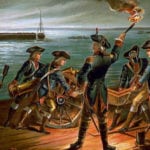 History
History  History
History  Weird Stuff
Weird Stuff 10 Superstitious Beliefs That Once Consumed Entire Cultures
 History
History 10 Bizarre Friendly Fire Incidents in Military History
 Technology
Technology 10 Modern Technologies That Accidentally Imitate Ancient Magic
 Mysteries
Mysteries 10 Mysteries of the Human Genome
 Weird Stuff
Weird Stuff 10 Things So Rare They’ve Only Been Found Once
 History
History 10 Legends Whose Last Moments Undid Their Glory
 Health
Health 10 Futuristic Ideas to Treat Common Medical Problems
 Weird Stuff
Weird Stuff Ten Surreal Attempts to Reverse Baldness
 Facts
Facts 10 U.S. Government Contingency Plans for the Unthinkable
 History
History 10 Odd Things Colonial Americans Kept at Home
 Weird Stuff
Weird Stuff 10 Superstitious Beliefs That Once Consumed Entire Cultures
 History
History 10 Bizarre Friendly Fire Incidents in Military History
Who's Behind Listverse?

Jamie Frater
Head Editor
Jamie founded Listverse due to an insatiable desire to share fascinating, obscure, and bizarre facts. He has been a guest speaker on numerous national radio and television stations and is a five time published author.
More About Us Technology
Technology 10 Modern Technologies That Accidentally Imitate Ancient Magic
 Mysteries
Mysteries 10 Mysteries of the Human Genome
 Weird Stuff
Weird Stuff 10 Things So Rare They’ve Only Been Found Once
 History
History 10 Legends Whose Last Moments Undid Their Glory
 Health
Health 10 Futuristic Ideas to Treat Common Medical Problems
 Weird Stuff
Weird Stuff Ten Surreal Attempts to Reverse Baldness
 Facts
Facts 10 U.S. Government Contingency Plans for the Unthinkable
10 Strange Yet True Historical Events
History is full of weird and wild things that most people go their entire lives without reading about. Stories about cat-related military operations or entire wars fought over pigs and emu. Here are 10 strange yet true historical events that are stranger than fiction.
Related: 10 Bizarre Events in the Age of Reason That Defied Reason
10 Operation Cat Drop
For the vast majority of people, cats are friends and family. But for the Royal Air Force military, cats are a weapon to protect billions of dollars in damage. Malaria was a pretty serious issue in the 1950s, prompting the World Health Organization to take action against it in affected areas. The WHO used DDT in Borneo to combat the rampant mosquito population, which was effective at first but quickly led to serious issues like wiping out animals like wasps and geckos and poisoning the wild food supply for the cat population.
With fewer cats around, rats surged in population. To combat this, they initiated Operation Cat Drop. Cats were put into crates and parachuted into Sarawak, Borneo, which completely replenished the cat population and led to a huge decrease in rats. By all accounts, it was a success, though the exact method of it hasn’t been done again for obvious reasons.[1]
9 The Pig War
Wars are always being fought over a multitude of things. Some reasons for war are stranger than others, like the infamous Pig War of 1859, which was fought between Great Britain and the United States. It all began with the 1846 Oregon treaty, which was supposed to give one of the nations control over the San Juan Islands for both military strategy and resource opportunity. However, ambiguous wording gave the U.S. and UK ownership over them, leading to heated conflict.
This tension erupted when a pig from the British company Hudson Bay Farm was shot by Lyman Cutlar, an American settler, igniting the great Pig War. The strangest thing about this conflict was that there weren’t any casualties or any open conflict. For the next 12 years, it was mostly a peaceful standoff that culminated with international arbitration deciding to give the United States full control of the islands in 1872. Though the war was mostly a strange occurrence, it went down in history as an example of small events triggering large disputes.[2]
8 Operation Paul Bunyan
Most of us will be familiar with the American folklore icon Paul Bunyan, a massive lumberjack known for his legendary strength that created landmarks like the Great Lakes and the Grand Canyon in Western mythology. Little do people know that there’s a military operation named after him called Operation Paul Bunyan, which involved the United States and North Korea. Back in 1976, the Korean Demilitarized Zone (DMZ) was the center stage for what almost led to full-scale nuclear warfare between the two nations.
A poplar tree was obstructing sight lines between checkpoints for the United Nations Command. This prompted them to send personnel to chop the tree down. This ended badly, however, as North Korean forces attacked and killed Captain Arthur Bonifas and First Lieutenant Mark Barrett, prompting Operation Paul Bunyan. A huge, heavily armed air and ground convoy of U.S. forces was sent in to make sure the tree was cut down properly, this time succeeding without a hitch. The whole thing went down in history as the Axe Murder Incident.[3]
7 Kentucky Meat Shower: 1876
When people hear “Kentucky” and “meat,” they typically think of fried chicken. However, on one unlucky and unpleasant day in 1876, citizens of Kentucky were subject to one of history’s weirdest and grossest events: the Kentucky Meat Shower. It all started on March 3, 1876, in Olympia Springs of Bath County, Kentucky. An apocalyptic amount of meat chunks of various sizes fell from the sky, covering a large 100-by-50-yard area.
Currently, there is no single accepted hypothesis for why this happened, but the most plausible one is that the meat chunks were vomited by a large flock of vultures flying above. It fits both the dispersion of the meat and the typical behavior of vultures, which is to vomit food when they feel threatened. A much more fun hypothesis is that the God of Meat was simply angry at Kentucky that morning.[4]
6 Year of Three Popes
Typically, a new pope stays as pope for the rest of his life or until he resigns, which then begins the process of finding a new one. In the year 1978, however, something strange happened. Pope Paul VI died on August 6, 1978, leading to the election of the new pope, Cardinal Albino Luciani, on August 26 of that same year. You’d think that he would surely last a decent while, right? Wrong, he passed away on September 28, 1978.
With two passings almost back to back, the Catholic Church was in a bit of a shamble and needed a replacement fast. On October 16, 1978, John Paul II was elected the new pope, and thankfully, he stayed alive for much longer. He was also the first non-Italian pope elected in over 455 years. This event hasn’t happened again and might not ever, but it’s certainly one for the books.[5]
5 The Battle of Los Angeles
The city of Los Angeles, California, is home to celebrity stardom, surfing, and some of the most bizarre history in any American town. You’d never expect an entire battle—or at least the preparation of one—to take place in Hollywood, but that exact thing happened right after the bombing of Pearl Harbor. It was February 25, 1942, and wartime tensions were understandably high for Americans, having just experienced an awful attack on Pearl Harbor by the Japanese military. But things took a turn for the worse.
An air raid alert sounded off around 2:00 a.m.: The U.S. military’s radar systems detected an unidentified object about 120 miles (193 km) to the west of Los Angeles. For the next couple of hours, an armada of heavy weaponry and armed personnel stormed LA, ready to defend the city. Over 1,400 anti-aircraft shells were launched into the sky. Combined with the numerous spotlights trying to find the object, it was quite a sight to see, creating so much chaos that it led to numerous traffic accidents and even five casualties. At the end of it all, it was deemed a false alarm, and the object was probably just a harmless weather balloon. Or was it?[6]
4 Phantom Barber of Pascagoula
One of the creepiest historical events you’ll ever read about happened during one strange summer in Pascagoula, Mississippi. The year was 1942, and World War II was hot in action. Residents of Pascagoula started reporting a man breaking into their homes at night and stealing not personal objects but locks of hair from various women. Edna Marie Hydel and Mary Evelyn Briggs were the first victims of the incident in June 1942. Pretty soon, scores of women reported locks of their hair missing, with one couple even being outright attacked by the suspected perp.
The town had had enough. By August 1942, local law enforcement arrested a 57-year-old chemist named William A. Dolan, whom they believed was the infamous phantom barber. He was tried and convicted of murder and sentenced to ten years in prison. Even though he denied these charges, the incidents dropped steeply after his imprisonment.[7]
3 Double Sunrise Flights
Everyone hates long flights; that’s just the truth of life. But nobody had a worse long flight than those flying Australian airline Qantas in July 1943. The fall of Singapore in 1942 severely damaged most of the flight routes from Australia to England, which was bad news for both businesses and civilians. Qantas decided to re-connect these two countries with an inaugural flight from Crawley to the Royal Air Force in Lake Koggola.
The problem is that there’s a lot of air distance to cover, meaning that the flight took 33 hours to complete. It was dubbed the “Double Sunrise” flight service because passengers could see two sunrises over the course of 3,580 nautical miles. The flight had to be done in secrecy due to the ongoing war efforts, and only about three passengers and essential mail were carried per flight to maximize fuel usage. These flights are still the longest commercial flights in international history.[8]
2 Year Without Summer: 1816
On the small, remote islands of West Nusa Tenggara, Indonesia, lies one of the tallest volcanos in the world, Mount Tambora. Although it is currently dormant, it was responsible for one of the most catastrophic eruptions in human history. On April 5, 1815, Mount Tambora exploded and sent over 36 cubic miles of volcanic ash and gas straight into the atmosphere. An Australian-sized aerosol cloud blocked out so much sunlight, leading to 1816’s “Year Without Summer.”
The aftermath was felt worldwide. Northeastern states in America, such as New York, Maine, and Massachusetts, suffered from ruined crops due to the bitter frost in spring. Ireland and India also suffered from ruined crops, disease pandemics, and civic chaos that took years to resolve. To date, it remains one of the most horrifying environmental disasters.[9]
1 An Ancient History Sporting Riot Almost Destroyed Constantinople
The Byzantine Empire was one of the most powerful and influential civilizations in history. They played a major role in both spreading Christianity and keeping many Roman and Greek cultural traditions alive. Despite their power, a simple sporting riot almost destroyed the capital city of Constantinople.
Chariot racing was fairly important to the Byzantine Empire, and two major chariot racing factions of the day, Blues and the Greens, had an intense rivalry that exploded into a full-on clash in AD 532. The Nika Riots were started by disagreements with Emperor Justinian’s politics and race-related disputes, leading to a large-scale razing of most of Constantinople. So many landmarks, like the Hagia Sophia, were destroyed, and over 30,000 people died. The riots were eventually quelled when Emperor Justinian deployed thousands of imperial troops to restore peace.[10]








